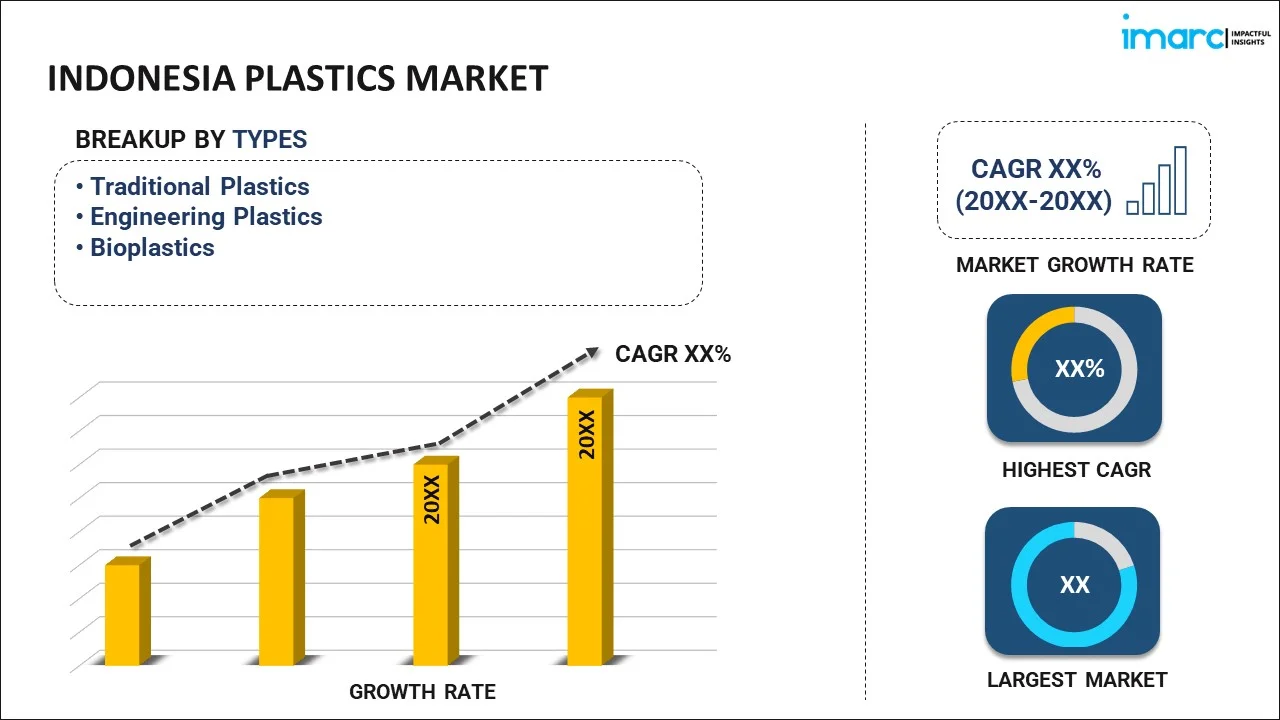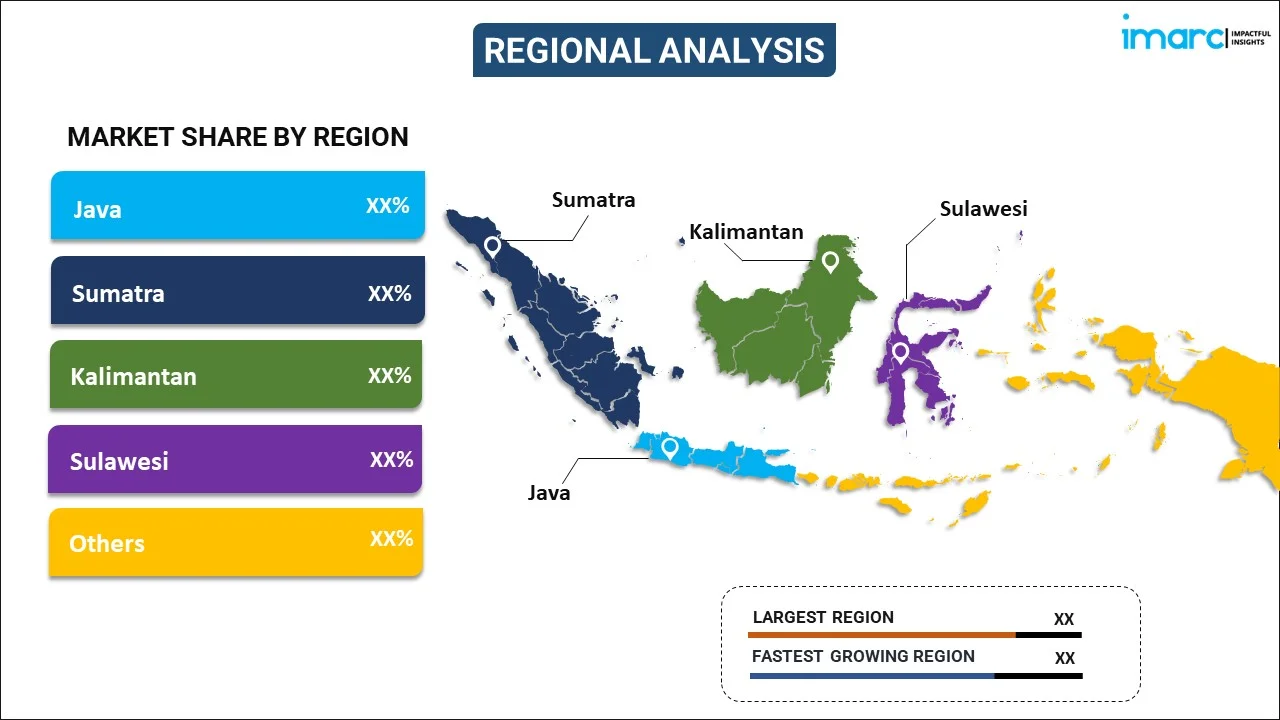
Indonesia Plastics Market Report by Types (Traditional Plastics, Engineering Plastics, Bioplastics), Technology (Injection Molding, Extrusion Molding, Blow Molding, and Others), Application (Packaging, Electrical and Electronics, Building and Construction, Automotive and Transportation, Furniture and Bedding, and Others), and Region 2024-2032
Market Overview:
Indonesia plastics market size is projected to exhibit a growth rate (CAGR) of 6.3% during 2024-2032. The increasing demand for plastics across various sectors such as packaging, construction, automotive, and consumer goods, the rise of e-commerce and modern retail formats, and rapid urbanization in the country represent some of the key factors driving the market.
|
Report Attribute
|
Key Statistics
|
|---|---|
|
Base Year
|
2023 |
|
Forecast Years
|
2024-2032 |
|
Historical Years
|
2018-2023
|
| Market Growth Rate (2024-2032) | 6.3% |
Plastics are a class of synthetic polymers made from various organic compounds, primarily derived from petroleum and natural gas. They have become an integral part of modern life due to their versatility, durability, and ease of production. These synthetic polymers are created through a process called polymerization, where smaller molecules called monomers are chemically bonded together to form long chains or networks. This molecular structure gives plastics their unique properties, including flexibility, strength, and resistance to degradation. There are many types of plastics, each with unique properties and characteristics. Common types include polyethylene (used in plastic bags), polypropylene (used in packaging and containers), polyvinyl chloride (PVC, used in pipes and vinyl products), and polyethylene terephthalate (PET, used in bottles). They also have numerous advantages, including their lightweight nature, corrosion resistance, and the ability to be molded into intricate shapes. Plastics are incredibly versatile and can be engineered to have specific properties, such as flexibility, transparency, heat resistance, or electrical conductivity. This versatility allows plastics to be used in a wide range of applications across industries like packaging, automotive, construction, electronics, healthcare, and more.
Indonesia Plastics Market Trends:
Indonesia has experienced steady economic growth in recent years. As the economy expands, there is an increased demand for plastics across various sectors such as packaging, construction, automotive, and consumer goods. The growth of these industries drives the consumption of plastic products. In addition, Indonesia is undergoing significant urbanization, with a growing urban population. Urbanization often leads to increased demand for plastic products for construction, infrastructure development, and consumer goods. Plastics are used extensively in building materials, pipes, and packaging, making them integral to urban development. Besides, the packaging industry is one of the largest consumers of plastics in Indonesia. The rise of e-commerce and modern retail formats has driven the need for efficient and attractive packaging solutions. Plastics, particularly flexible packaging, are preferred for their cost-effectiveness, durability, and ability to protect products. Moreover, Indonesia has a growing manufacturing sector, including automotive and electronics industries. These sectors rely heavily on plastic components and materials for various applications, including automotive parts and electronic casings. Additionally, plastics are extensively used in the production of consumer goods, ranging from household items to electronics. As the middle-class population grows and consumer preferences evolve, the demand for plastic consumer products also increases. Furthermore, both domestic and foreign companies are investing in the Indonesian plastics industry. This influx of capital leads to technological advancements, increased production capacity, and a broader range of plastic products available in the market.
Indonesia Plastics Market Segmentation:
IMARC Group provides an analysis of the key trends in each segment of the market, along with forecasts at the country level for 2024-2032. Our report has categorized the market based on type, technology, and application.
Type Insights:

- Traditional Plastics
- Polyethylene
- Polypropylene
- Polyvinyl Chloride
- Polystyrene
- Engineering Plastics
- Polyethylene Terephthalate (PET)
- Polybutylene Terephthalate (PBT)
- Polycarbonates (PC)
- Styrene Polymers (ABS and SAN)
- Fluoropolymers
- Polyoxymethylene (POM)
- Polymethyl Methacrylate (PMMA)
- Polyamide (PA)
- Others
- Bioplastics
The report has provided a detailed breakup and analysis of the market based on the type. This includes traditional plastics (polyethylene, polypropylene, polyvinyl chloride, and polystyrene), engineering plastics (polyethylene terephthalate (PET), polybutylene terephthalate (PBT), polycarbonates (PC), styrene polymers (ABS and SAN), fluoropolymers, polyoxymethylene (POM), polymethyl methacrylate (PMMA), polyamide (PA), and others), and bioplastics.
Technology Insights:
- Injection Molding
- Extrusion Molding
- Blow Molding
- Others
A detailed breakup and analysis of the market based on the technology have also been provided in the report. This includes injection molding, extrusion molding, blow molding, and others.
Application Insights:
- Packaging
- Electrical and Electronics
- Building and Construction
- Automotive and Transportation
- Furniture and Bedding
- Others
The report has provided a detailed breakup and analysis of the market based on the application. This includes packaging, electrical and electronics, building and construction, automotive and transportation, furniture and bedding, and others.
Regional Insights:

- Java
- Sumatra
- Kalimantan
- Sulawesi
- Others
The report has also provided a comprehensive analysis of all the major regional markets, which include Java, Sumatra, Kalimantan, Sulawesi, and Others.
Competitive Landscape:
The market research report has also provided a comprehensive analysis of the competitive landscape in the market. Competitive analysis such as market structure, key player positioning, top winning strategies, competitive dashboard, and company evaluation quadrant has been covered in the report. Also, detailed profiles of all major companies have been provided.
Indonesia Plastics Market Report Coverage:
| Report Features | Details |
|---|---|
| Base Year of the Analysis | 2023 |
| Historical Period | 2018-2023 |
| Forecast Period | 2024-2032 |
| Units | US$ Million |
| Scope of the Report | Exploration of Historical Trends and Market Outlook, Industry Catalysts and Challenges, Segment-Wise Historical and Future Market Assessment:
|
| Types Covered |
|
| Technologies Covered | Injection Molding, Extrusion Molding, Blow Molding, Others |
| Applications Covered | Packaging, Electrical and Electronics, Building and Construction, Automotive and Transportation, Furniture and Bedding, Others |
| Regions Covered | Java, Sumatra, Kalimantan, Sulawesi, Others |
| Customization Scope | 10% Free Customization |
| Report Price and Purchase Option | Single User License: US$ 3699 Five User License: US$ 4699 Corporate License: US$ 5699 |
| Post-Sale Analyst Support | 10-12 Weeks |
| Delivery Format | PDF and Excel through Email (We can also provide the editable version of the report in PPT/Word format on special request) |
Key Questions Answered in This Report:
- How has the Indonesia plastics market performed so far and how will it perform in the coming years?
- What has been the impact of COVID-19 on the Indonesia plastics market?
- What is the breakup of the Indonesia plastics market on the basis of type?
- What is the breakup of the Indonesia plastics market on the basis of technology?
- What is the breakup of the Indonesia plastics market on the basis of application?
- What are the various stages in the value chain of the Indonesia plastics market?
- What are the key driving factors and challenges in the Indonesia plastics?
- What is the structure of the Indonesia plastics market and who are the key players?
- What is the degree of competition in the Indonesia plastics market?
Key Benefits for Stakeholders:
- IMARC’s industry report offers a comprehensive quantitative analysis of various market segments, historical and current market trends, market forecasts, and dynamics of the Indonesia plastics market from 2018-2032.
- The research report provides the latest information on the market drivers, challenges, and opportunities in the Indonesia plastics market.
- Porter's five forces analysis assist stakeholders in assessing the impact of new entrants, competitive rivalry, supplier power, buyer power, and the threat of substitution. It helps stakeholders to analyze the level of competition within the Indonesia plastics industry and its attractiveness.
- Competitive landscape allows stakeholders to understand their competitive environment and provides an insight into the current positions of key players in the market.
Need more help?
- Speak to our experienced analysts for insights on the current market scenarios.
- Include additional segments and countries to customize the report as per your requirement.
- Gain an unparalleled competitive advantage in your domain by understanding how to utilize the report and positively impacting your operations and revenue.
- For further assistance, please connect with our analysts.

 Inquire Before Buying
Inquire Before Buying
 Speak to an Analyst
Speak to an Analyst
 Request Brochure
Request Brochure
 Request Customization
Request Customization



.webp)




.webp)












